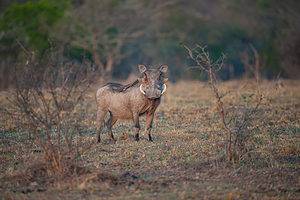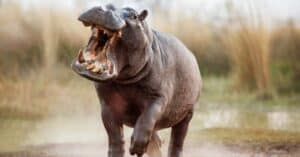The Alaskan malamute and Siberian husky are a pair of loyal, friendly, and dedicated dogs, rooted in the work for which they were originally bred. While both breeds have found their way into the homes of pet owners, their stature and even the amount of exercise that they need vary greatly. Even their care, cost, and lifespan can make the difference in which one you choose to adopt.
The two dogs feature similar black, grey, and white coats, and they even have distinct noses that cannot be differentiated. As we explore their origins and nature, the true characteristics and physical traits help anyone to decide which pet is right for them.
Comparing Malamute vs Husky
In the following chart, we’ve identified some of the key differences between the malamute and the husky. While the Alaskan malamute is part of the Spitz dog family, the Siberian husky is classified as a working dog, but they both vary in size, temperature preferences, and more.
| Malamute | Husky | |
|---|---|---|
| Size | 22-26 inches tall | 20-24 inches tall |
| Lifespan | 10-12 years | 12-15 years |
| Preferred climate | Prefers the cold, may take longer to adapt to warm weather. | Adaptable to any climate, from freezing temperatures to tropical areas. |
| Tail | Curled | Straightened |
| Purebred price | $1,200-$2,000 | $600-$1,300 |
The 7 Key Differences Between Malamutes and Huskies
When you’re adopting a dog, you want to make sure you know what you’re getting into. However, the confusion between the malamute and the husky goes back quite some time.
The Siberian Husky was originally bred as a pulling/worker dog breed. They were bred to help people carry belonging lost distances. The Alaskan Malamute was bred to pull heavy loads, whereas huskies can handle longer trails. A good way to compare the two breeds is that huskies are large and strong and malamutes are light and nimble.
Everyone seems to think they know the true differences in the breeds, but do they?
Both animals have a notable build and similar sizes, but there are 6 major differences that we’ll cover here.
Malamute vs Husky: Eye Color
One of the easiest ways to tell huskies and malamutes apart is by their eye color. Almost always, purebred malamutes will have brown eyes, as they do not carry the gene for blue eyes. Huskies, on the other hand, will have blue eyes or heterochromia (two different colored eyes).
Malamute vs Husky: Curly vs. Extended Tail
The easiest way to tell a malamute from a husky is the tail. Through years of breeding, the curly tail is an evolutionary trait, helping the dog to keep its body and face warm as they curl up. It is also far bushier than the husky’s tail, which often is fully straightened.
Malamute vs Husky: Relation to the Wolf
If you’re not sure where the malamute gets its good looks, go no further than the wolf! The breed was developed nearly 3,000 years ago, and its size is much closer to that of a wolf. According to legend, the Inuits that bred them would leave their dogs tied to a tree in the forest in the hopes that a wolf would mate with them to improve their strength.
The husky doesn’t have nearly the same genetics as the wolf. Instead, the breed is closer to the Spitz dog family, which includes dogs like Pomeranians and Akitas.
Malamute vs Husky: Tribal Breeding Around the World
While it is clear that genetics are rooted in different breeds, the husky and the malamute come from entirely different parts of the world. The husky originally came from Northeast Asia, and it was bred to be a sled dog by the Chukchi people. It wasn’t until the 20th century that the Siberian husky ever made it to the United States at the request of the Alaskan people.
The malamute, on the other hand, was bred directly in northwestern Alaska by the Mahlemut, which is a nomadic Inuit tribe in the area. Instead of working as sled dogs, the Mahlemut used them as protection from polar bears and to hunt seals. However, they would sometimes work to pull along supplies over large distances like sled dogs.
Malamute vs Husky: Taking Care of Grooming
As beautiful as both dogs can, grooming is absolutely essential. The husky requires a lot less work to keep up their coat, only requiring a brushing every week and a bath a few times a year. Malamutes are incredibly high maintenance, and the only way to keep shedding and mats to a minimum is daily brushing and a bath every 6-8 weeks.
Malamute vs Husky: Full of Personality
Each of these dogs has a reputation as a pack animal, full of love for their families. However, the husky much prefers to stick with its human family and does not love being left behind. Malamutes will be independent on their own terms, and they may thrive as only pets.
Malamute vs Husky: Exercise Needs
There’s no doubt that both huskies and malamutes need to get outside and get moving, but the way that they get the most out of exercise varies greatly. Huskies thrive on speed-based exercise, running around in a large backyard and even in a large living room to get their energy out. The malamute, on the other hand, likes to get a little work in, carrying along whatever might be needed for the adventure. Even if they are just in charge of a small backpack with their water dish, they like a little extra work in their movement.
Summary: Husky vs Malamute
| Husky | Malamute |
|---|---|
| Blue eyes Heterochromia | Brown eyes |
| Straight tail | Curled tail |
| Not as close to wolves genetically | Genetically close to wolves |
| Originated in Northeast Asia by the Chukchi people | Bred in Alaska by the Mahlemut Inuit tribe |
| Brush weekly Bathe few times a year | Brush daily Bathe every 6-8 weeks |
| Pack mentality | Pack mentality with an independent side Prefer to be only pet |
| Speed-based exercise | Working dogs |
Up Next…
- Aussiedoodle vs Labradoodle: Top Differences – Both doodles but of different breeds, these dogs make great companions.
- Silver Lab vs Weimaraner: 5 Key Differences – These dogs look very similar but they are completely different dogs.
- English Springer Spaniel vs English Cocker Spaniel – Spaniels are energetic, family-oriented dogs but they do have their differences.
The photo featured at the top of this post is ©
FAQs (Frequently Asked Questions)
What is the size difference between a Malamute and a Husky?
The size of the malamute and the husky is fairly similar, though malamutes tend to be taller. While a husky stands about 20-24 inches tall, the malamute stands 23-25 inches tall.
How closely related are malamutes and huskies to wolves?
While a husky is far from the genetic pool of the wolf, malamutes share many traits with their ancestors.
How is the tail of a Husky different from the tail of a Malamute?
The tail of a husky is extended, while the malamute’s tail creates a springing curl.
Where is the malamute originally from? Where is the husky originally from?
Though the husky originally came from Northeast Asia by the Chukchi, the malamute was originally bred in Alaska by an Inuit tribe.
Thank you for reading! Have some feedback for us? Contact the AZ Animals editorial team.






